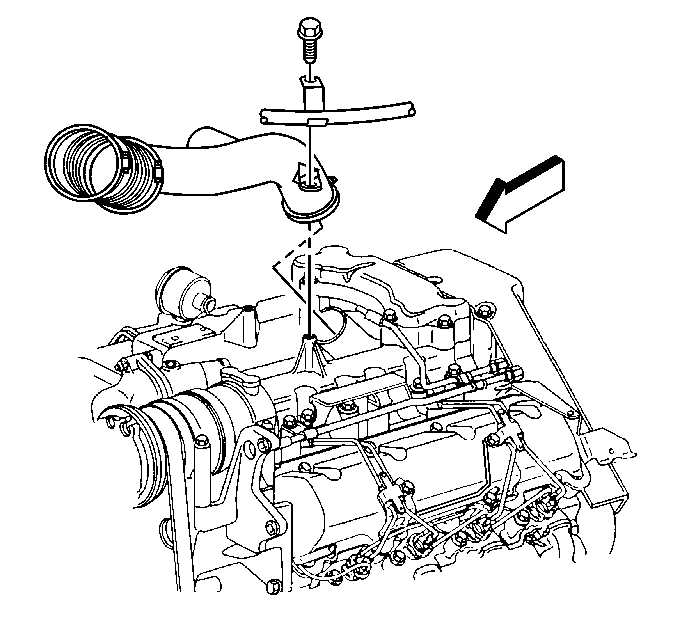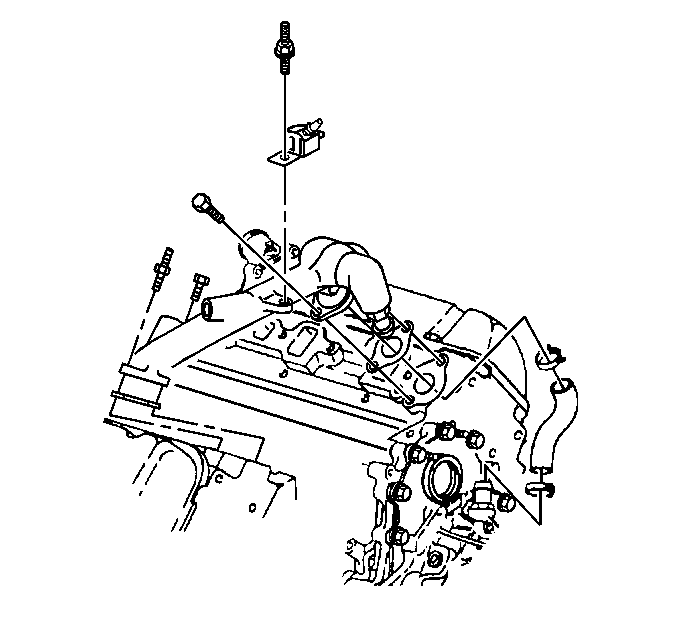Thermostat Housing Crossover Replacement 6.5L
Removal Procedure
- Disconnect both battery negative cables. Refer to Battery Negative Cable Disconnection and Connection in Engine Electrical.
- Drain the coolant from the radiator. Refer to Cooling System Draining and Filling .
- Remove the air cleaner assembly from the vehicle. Refer to Air Cleaner Assembly Replacement in Engine Controls-6.5L (L65).
- Remove the air intake duct from the turbocharger.
- Remove the nut securing the engine oil level indicator tube and the transmission fluid level tube at the thermostat housing.
- Remove the stud securing the fuel bleed valve at the thermostat housing.
- Remove the A/C compressor. Refer to Air Conditioning Compressor Replacement in Heating, Ventilation, and Air Conditioning.
- Disconnect the coolant temperature sensor electrical connector.
- Disconnect the heater hose at the thermostat housing crossover.
- Disconnect the by-pass hose at the thermostat housing crossover.
- Disconnect the radiator inlet hose at the thermostat housing crossover.
- Remove the studs and bolts securing the thermostat housing crossover to the engine.
- Remove the thermostat housing crossover.
- Clean the thermostat housing crossover sealing surfaces.




Installation Procedure
- Install the new gaskets.
- Install the thermostat housing crossover.
- Install the studs and bolts retaining the thermostat housing crossover to the engine.
- Connect the radiator inlet hose to the thermostat housing crossover.
- Connect the by-pass hose to the thermostat housing crossover.
- Connect the heater hose to the thermostat housing crossover.
- Connect the electrical connector to the coolant temperature sensor.
- Install the A/C compressor. Refer to Air Conditioning Compressor Replacement in Heating Ventilation and Air Conditioning.
- Install the stud in order to secure the fuel bleed valve at the thermostat housing.
- Install the nut in order to secure the dipstick tubes at the thermostat housing.
- Refill the engine cooling system. Refer to Cooling System Draining and Filling .
- Bleed the air from the engine cooling system by the following:
- Install the air intake duct to the turbocharger.
- Install the air cleaner assembly in the vehicle. Refer to Air Cleaner Assembly Replacement in Engine Controls-6.5L (L65).
- Inspect the system for coolant leaks.

Notice: Use the correct fastener in the correct location. Replacement fasteners must be the correct part number for that application. Fasteners requiring replacement or fasteners requiring the use of thread locking compound or sealant are identified in the service procedure. Do not use paints, lubricants, or corrosion inhibitors on fasteners or fastener joint surfaces unless specified. These coatings affect fastener torque and joint clamping force and may damage the fastener. Use the correct tightening sequence and specifications when installing fasteners in order to avoid damage to parts and systems.
Tighten
Tighten the bolts and studs to 47 N·m (35 lb ft).


Connect the battery negative cables to the battery terminals. Refer to Battery Negative Cable Disconnection and Connection in Engine Electrical.
| 13.1. | Remove the cap from the surge tank. |
| 13.2. | Remove the bleed screw, a slotted screw, from the top of the thermostat housing. |
| 13.3. | Pour anti-freeze into the surge tank, and watch for a of anti-freeze from the bleed screw. |
| 13.4. | When a constant flow of anti-freeze is reached, closed the bleed screw at the top of the thermostat housing. |
| 13.5. | Continue to fill the surge tank to the proper level. |
| 13.6. | Install the cap on the surge tank. |

